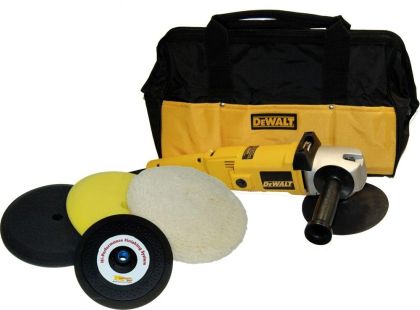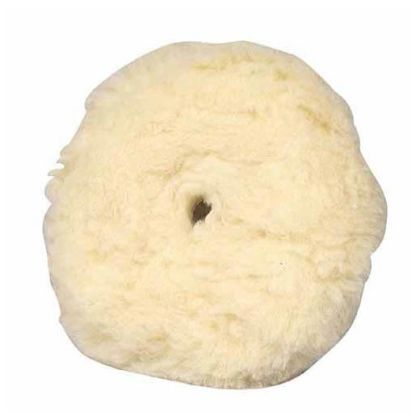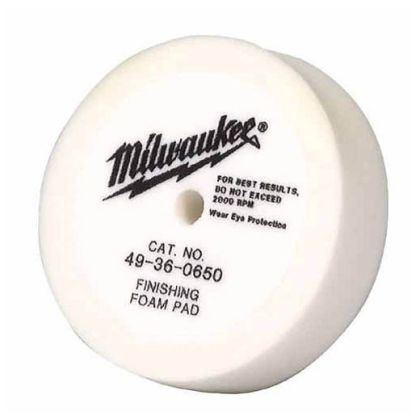Why Read This Article?
Finish Nailer Repair - Replacing the Driver Guide (Ridgid Part # 79004001022)
Article Breakdown
Finish Nailer Repair - Replacing the Driver Guide (Ridgid Part # 79004001022)

Customers should be warned, though, that some manufacturers often use their own system for distinguishing pad differences (usually a color coded system) for both wool and foam pads, but these systems are not standardized across the industry and can often lead to confusion. It's usually best for shoppers to choose pads from knowledge of specific design and material details.
The information below covers the factors that effect a polishing pad's performance, applications for different types of pads, and major types of polishing pads.
Polishing Pad Basics
High speed polishing pads are most often used on grinders and orbital machines for wet, dry, compound, and other kinds of polishing. They are also used to buff different compounds into a variety of surfaces, like auto paint and metals.
Most of the work that polishing pads do is in the delicate, 1500 to 2000 grit range that is necessary to produce a shine.
The work that polishing pads do gets broken up into four major areas of polishing: "cutting," buffing, finishing, and compounding.
- "Cutting" refers to the work that the grittier end of polishing pads do, as they more-aggressively remove material and oxidation from their application surface.
- Buffing is the intermediate step of middle-range aggression pads that begins to develop a polish, picking up where the cutting stage leaves off.
- Finishing involves using the lowest grit pads to remove buff marks and any other damage left over and/or caused by buffing.
- Compounding is any kind of polishing that involves the use of a compounding liquid/substance. Compounding liquids contain suspended abrasives of various grits to aid in some kinds of cutting and polishing.
The biggest distinction between polishing pad types lies between wool and foam pads, and is the first consideration to make when choosing a pad. In general, wool pads are for more aggressive work and require less user finesse to use correctly. Foam pads are generally used for more delicate, finishing work, and require a little more skill on the user's part to operate. [Back to top]
Wool Polishing Pads Generally more aggressive and easy to use than foam polishing pads, wool pads are designed in varieties that cover a range of uses, and are the only pads needed for some jobs. Wool pads are easier for users to handle than foam pads because of their long fibers. While in use, these fibers lie down to some degree or another, giving the user a little bit of play in the bounce of the machine and the resistance of the pad to the surface it's being used on.

They cut more aggressively, because their many fibers produce more abrasive surface area than foam pads, optimizing them for cutting and buffing applications.
Another advantage to wool pads is that they produce less heat than foam pads, meaning less risk of damaging the polishing surface. Synthetic wool materials produce more heat than natural wool.
Wool pads are also limited because of their aggression, although some wool materials and designs compensate for this. Generally, wool pads tend to leave more and deeper buffing marks that have to be cleaned up by lower grit pads.
Polishing often involves starting with wool pads for cutting, and then switching to foam pads for finish and shine.
Below are some tips that explain how wool polishing pad grit and aggression are determined, and some descriptions of major types of wool polishing pads.
[Back to top]
Wool Pad Aggression
Unlike other abrasives, wool polishing pad aggression is not controlled by the grain size of abrasive materials in the pads, because they lack abrasive grains. For wool pads, the only abrasive material needed is the wool.
This means that wool pad grit and aggression are controlled by other properties: pile length, pile density, and the kind of wool (or synthetic wool) being used.
"Pile" refers to the piles of wool fibers grouped together and their orientation.
pile length-
As wool polishing pad fibers grow longer, the pads become less aggressive. This is by simple virtue of physics, in that longer fibers will lie down more when the pad is in use, and shorter fibers will be stiffer and work against the polishing surface more.
pile density-
The density of wool fibers in a polishing pad is another partial contributor to the aggression of the pad. Higher density increases aggression slightly because more fibers are available to contact the polishing surface per square inch.
Pile density also effects how well a wool pad works for compounding applications, as denser pads will hold more compounding solution.
materials-
The type and blend of wool used in a polishing pad greatly determines its grit.The wool pad material types in the next subsection are listed in order of decreasing aggression (except 4-Ply Twisted Wool, because it is a feature available in many pad types).
Natural wool is the most aggressive, blends of synthetic and natural wool become less aggressive as more synthetic wool is used, then, synthetic wool pads are the next least aggressive, and then, finally, lamb's wool pads are the least aggressive of the wool pads.
Wool and foam combination pads are designed to give the pads a wide range of possible applications.
[Back to top]
Wool Pad Types
The common types of wool polishing pads listed below are in order of decreasing grit (generally), going down the list.
Natural Wool-
Low on heat and the most aggressive of the wool pads. Natural wool pads leave fewer buff marks than other wool pads (despite their grit), their fibers retain their shape better, and they are less likely to shed fibers during use.
Blended Wool-
There are endless varieties and balances of synthetic/natural wool polishing pads. Pads become less aggressive as the ratio shifts in favor of synthetic wool.
Wool/Acrylic Blend-
A 50/50 natural wool to acrylic fiber blend is one very common type of blended wool pad. This unique blend gives the pads a wider range of application, from light compounding to heavy polishing.
Synthetic Wool-
Less cutting aggression than natural wool pads. Synthetic wool is also very durable.
These are used for moderate cutting, but pose the danger of heat damage to the polishing surface, because synthetic wool pads heat up more than any other wool pad.
Wool and Foam-
Wool and foam combination pads use a patented process that forms wool fibers into a disk that is much like foam abrasive pads. This design bridges many qualities of both wool and foam pads, allowing them to do work from light cutting to finishing. The idea is that they are the only pads needed, start to finish, for many polishing jobs.
Lamb's Wool-
Lamb's wool pads are more expensive than other wool polishing pads, but they are the softest and least abrasive. Lamb's wool polishing pads are great for light clear coat polishing and finishing.
4-Ply Twisted Wool-
This is not a type of wool material, but a manufacturing feature that can be applied to different kinds of wool polishing pads. They are most commonly used for heavy compounding,
The fibers of these pads are twisted, making them much more durable. 4-ply twisted wool pads are much more aggressive than other pads, especially when being used with compounding liquid, but the real advantage here is that the pads will last longer and will operate in the same grit range longer, as they tend to wear down more slowly.
[Back to top]
Foam Polishing Pads
Foam polishing pads are used for the lower grit work of polishing applications to remove swirl lines, light oxidation, and bring out a shine.

Color code systems for these pads can be misleading and confusing, so it's best just to look at each individual pad's features and intended application.
Foam pads are generally harder to handle on high speed polishers than wool pads, and they also create more heat.
One advantage to foam pads is that they dry up compounding substances less quickly than wool pads, so users have to stop less frequently when using foam pads.
Because color codes and other "rules" can be ambiguous when shopping for foam pads, we recommend focusing on the following features to get a good match:
Pores per square inch (ppi)-
Because foam pads are often used for compounding, the density of pore distribution on the pad greatly effects how much compounding substance the pad can hold, and, consequently, how aggressive the pad is when compounding.
Fewer pores per square inch means more aggression, because bigger pores will be able to hold more compounding liquid and compounding liquids of higher grit. Higher ppi means less compounding aggression.
Foam pads with a higher ppi are better for use with wax than with abrasive compounding substances. Ppi generally ranges between 30 and 100 pores per square inch.
Hardness-
Different brands of foam pads can indicate the pad's hardness in different ways.
Some manufacturers may use a grit scale, while others will just indicate the kind of work for which the pad is intended (like cutting, finishing, ultra finish, etc.). Do the best with whatever information is offered to determine the pad's hardness.
Special features-
Foam pad manufacturing technology is constantly changing and improving, which is one of the reasons why it's hard to make concrete rules about foam polishing pads.
Many manufacturers showcase special pad features and patented processes that improve pad performance one way or another. Most of these features will boil down to personal preference, so learn as much about technology and unique pad designs as possible.
[Back to top]
Conclusion
Our large inventory of power tool and equipment accessories includes a selection of wool and foam polishing pads here at eReplacementParts.com, and can be found on our Polishing Pads accessories page.
We want our customers to have the best information tools at their disposal so they can be confident that they're getting their money's worth when shopping for replacement parts, accessories, and other products that require a little know-how.
If you're looking for abrasive power tool accessories, like polishing pads, visit our Abrasives accessories page and take advantage of our fast search features, and speedy online service.
[Back to top]
What we're about.


















































